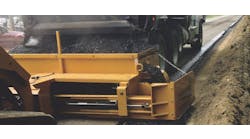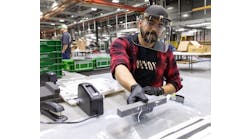By: George Zafirov
Kicked in the side. Pushed onto sharp objects. Rolled through muck and mud. Life in skid row can be rough—and so can the life of a skid-steer tire. While it takes a level of toughness to be a skid-steer tire, it could be even tougher trying to determine which one will work best for you. There are numerous styles and strengths on the streets. You may as well take the easy way out and just choose the cheapest set available. Those should work fine, right?
Well, yes, they will work, but they eventually could cost you more than the higher-priced models. Spend some time looking at tire options before buying and it could save you from spending more money in the end.
Why does it matter?
When comparing a $100 tire to a $500 tire, one difference is obvious—the price. It is important to look beyond the initial cost, however, and consider what the tire expenses may amount to over its lifetime, and how long that service life might be.
For starters, a good tire will decrease downtime and, in turn, lessen operating costs. When a tire goes flat, the cost is not only in the repair. The greater expense comes in the lost productivity as the flat is repaired or replaced. Additionally, the shorter a skid-steer tire’s service life, the more often replacements will be needed.
Preventive maintenance also takes time with some tires, which should be calculated when considering costs. To reduce wear and fuel consumption, a pneumatic tire will need regular air pressure checks to ensure it is at the recommended levels.
Another thing to keep in mind is that any suspension on a skid steer comes from the tire. Tires with little flexibility will cause the operator to feel every rock and bump, making for a pretty uncomfortable ride. As most contractors know, a comfortable operator is a productive operator, but the effects can be felt even further. This lack of pliability can impact the skid steer’s components, leading to damage from the jarring motions. A rigid ride also may affect the load, causing it to shift and possibly fall when the skid steer rolls over a larger item, leading to damage and potential injury.
What’s out there?
Once realizing the importance of choosing a good skid-steer tire, examine the types available on the market. Four main styles give consumers a variety of choices: pneumatic, solid, foam-filled and semi-pneumatic.
Pneumatic, or air-filled, tires are by far the most commonly used because they come standard with most, if not all, brands of skid steers. Not only is this style the least expensive—$500 to $1,000 per set—but also it provides the smoothest ride since the air can best absorb objects and debris on uneven surfaces.
The very thing that makes a pneumatic tire ride smoothly also is its greatest downfall: air. Leaks and puncture holes lead to flat tires, which commandeer productivity time by forcing operators to stop. Repairing or replacing a flat adds to the cost. Pneumatic tires also may blow out, which may cause injuries or affect a load being carried.
To address time-draining flats, the industry developed solid rubber tires that can drive over metal shards and broken glass but keep on rolling. Besides being flat-proof, solid tires also last longer since there is no tread, which means a larger contact area with the work surface. With treaded tires, the wear is concentrated on the raised portions only, while solid tires spread the wear out across the entire surface. This lack of tread has a downside, though: Tread provides traction, a necessity on some challenging jobsites.
Solid tires prevent the problems associated with pneumatic tires—flats—but they cannot provide the benefits also associated with pneumatic tires. The solid construction has little flex, causing a bumpy ride, especially over rough terrain. Besides being uncomfortable for the operator, it can wreak havoc on a skid steer’s axle as it is jolted and bumped, potentially damaging the machine. Solid tires also weigh about 140 to 240 lb—three to four times as much as air-filled models. The versatility of using over-the-tire tracks also is eliminated with solid tires, which cannot be paired with tracks. Additionally, a solid tire’s price, about $1,800 to $2,500 per set, is no match for the inexpensive pneumatics.
Given all of that, why not split the difference? Foam-filled tires attempt to bridge the gap between pneumatic and solid tires by taking the hollow rubber tube of a pneumatic and filling it with polyurethane foam. This combination makes foam-filled tires virtually impervious to flats while giving the machine a smoother ride than a solid tire can provide. It also splits the price point—foam-filled tires cost more than pneumatics but less than all-rubber. It generally costs $100 to $215 to fill a single pneumatic tire with foam, or about $650 to $1,000 to purchase a set of foam-filled tires.
Foam tires offer treads, making them more effective on rough terrain, but more susceptible to wear, than solid tires. Jagged ground may eventually damage a foam-filled tire, however, at which point the foam can leak and render the tire useless. Additionally, most foam is a petroleum-oil-based compound, which poses an environmental hazard if it leaks. When it is time to remove the tire, it will need to be cut off of the rim, which could damage the wheel. The alternative would be to dispose the tire and rim altogether, increasing waste and replacement costs.
Weight also presents issues for foam-filled tires and can put additional strain on the transmission, which may lead to breakdowns. The axles, undercarriage and suspension also may suffer from the added weight as the skid steer works harder under the load. This is especially problematic when pneumatic tires are filled with foam but left on rims designed for the lighter pneumatic tires.
The fourth tire style, semi-pneumatic, is the newest arrival on the skid-steer scene. It is an attempt to improve on the foam-filled tires’ efforts to find a happy medium between pneumatic and solid. Rather than using compressed air, as pneumatic tires do, semi-pneumatic tires are built with strategically placed holes in the rubber to provide shock absorption. The result makes the tire flat-proof, while still incorporating air pockets for a cushioned ride replicative of a pneumatic tire.
At about $1,300 to $2,200 per set, semi-pneumatic tires cost more than pneumatics, but a semi-pneumatic tire’s life span is at least three times longer, according to most manufacturers. Besides being flat-proof, deeper treads provide for better traction and a longer wear factor on the semi-pneumatics, which also are designed to self-clean objects stuck in the tread or airholes.
Which to choose?
All four tire options present benefits and drawbacks. Application will be the best predictor in helping to choose the best option for a skid steer.
For instance, a skid steer operating in a recycling yard would be best suited for solid tires. The all-rubber construction would best handle the abundance of unavoidable, jagged items. Additionally, the lack of a tread would be of little concern since these applications typically offer smooth, flat surfaces on which to work.
If the application requires good traction, a semi-pneumatic tire would be a better fit since the deep treads provide strong traction and long wear while still preventing flats in challenging work environments.
When working on smooth pavement, a pneumatic tire will likely be the best bet. There is considerably less worry of a flat than in other work environments, so the cost-benefit ratio should be best with a pneumatic provided there is little chance of a flat.
When it comes to landscaping operations and work on turf, the lug tread pattern is the most important factor. While the tire weight is important, it is only a fraction of the machine’s weight, which reduces its importance in the overall operation. A tread pattern with more surface contact will reduce the pressure on the operating surface by distributing the pounds-per-square-inch pressure over a greater area.
Once the application determines the tire type, narrow the decision by looking at quality features within that classification. For instance, ensure that the carcass strength can handle the weight of the machine and any load it might carry. Cords running through the sides of pneumatic tires contribute to the strength of the tire’s carcass. The term “ply rating” may be mentioned, too, but it is a bit of an outdated term. In the past, it referred to the number of cotton cords lining a tire. As stronger fibers replaced cotton, and varied in numbers based on each material’s strength, the definition has shifted to coincide with carcass strength.
Look at the strength of the sidewalls. Will it resist the cuts and snags a skid steer may experience in severe operating conditions? This will be especially important for pneumatic and foam-filled tires since solid and semi-pneumatic tires can handle sidewall punctures.
No matter the tire style, look at the lug size—the raised part of the tread—since the deeper the lugs are, the better traction the tire will have in slippery conditions. Likewise, the larger the void size—the space between the lugs—the greater the traction. No voids, however—a treadless tire, in other words—will have the opposite effect.
Consider the tires’ versatility. While it would be unsafe to use solid or foam-filled tires with over-the-tire tracks, pneumatic and semi-pneumatic tires offer the proper shock absorption to make this a suitable operating alternative.
Also, look for a manufacturer that will guarantee the tire. A “satisfaction guarantee” gives an added level of assurance that the purchased product will immediately meet expectations, while a warranty further ensures a quality tire.
Skid steers’ popularity on challenging construction jobsites has increased dramatically during the past decade. The tires should be able to stand up to those challenges, as long as the tires fit the application. Knowing what to look for ahead of time can prevent the problems and expense an inadequate skid-steer tire may cause down the road. Choosing the best tire for the job will ultimately drive down operating costs while increasing productivity.
Material, tread, traction, versatility, reliability—the list of characteristics to consider may seem tiring. But a bit of homework with the application in mind will make short work of the selection process.
About The Author: Zafirov is marketing manager for McLaren Industries.

